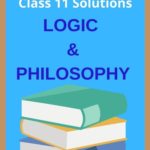Class 11 Logic And Philosophy Chapter 13 Pramāna: Pratyaksa and Anumana The answer to each chapter is provided in the list so that you can easily browse throughout different chapters SCERT Class 11 Logic And Philosophy Chapter 13 Pramāna: Pratyaksa and Anumana and select need one.
Class 11 Logic And Philosophy Chapter 13 Pramāna: Pratyaksa and Anumana
Also, you can read the SCERT book online in these sections Solutions by Expert Teachers as per SCERT (CBSE) Book guidelines. These solutions are part of SCERT All Subject Solutions. Here we have given Assam Board Class 11 Logic And Philosophy Chapter 13 Pramāna: Pratyaksa and Anumana Solutions for All Subjects, You can practice these here…
Pramāna: Pratyaksa and Anumana
Chapter – 13
LOGIC & PHILOSOPHY
VERY SHORT TYPES QUESTIONS AND ANSWERS
Answer the following Questions :
(a) In Indian philosophy valid knowledge is known as
Ans : Pramā
(b) In a indian philosophy there are pramānas.
Ans : Six
(c) According to carvākas………. is the only source
of valid knowledge.
Ans : Perception.
(d) The Nyāya school admits ……… pramūnas.
Ans : Four.
(e) ……….. Is the logical ground of Inference.
Ans : Vyāpti
2. Choose right or wrong.
(a) Cārvāka accept both perception and inference as valid pramāna
Ans : Wrong.
(b) Pratyaksa is independent cognition.
Ans : Right.
(c) Everyone can achieve yogaja pratyaksa.
Ans : Wrong.
(d) Every Indian philosophical system admits validity of inference as a pramāna.
Ans : Wrong.
(e) inference is a mediate knowledge.
Ans : Right.
(f) There are four terms in an inference.
Ans : Wrong.
(g)In parārthānumāna five avayavas are expressed.
Ans : Right.
(h) The middle term relates the major term and the minor term.
Ans : Right.
(i) Sarārthānumāna is an inference to convince others.
Ans : Wrong.
3. Give brief answer :
(a) What is prama?
Ans : True cognition or valid knowledge is called pramā.
(b) What is pramana?
Ans : Pramana is the means by which true cognition or valid knowledge is achieved
(c) What are the pramānas recognized by Indian Philosophy?
Ans : There are six Pramānas recognized by Indian philosophy, viz.
(i) Pratyaksa or Perception,
(ii) Anum āna or Inference,
(iii) Sabda or Verbal testimony,
(iv) Upamäna or comparison,
(v) Arthapatti or postulation and
(vi) Anupalabdhi or non-perception.
| Sl. No. | Contents |
| Unit – 1 | Logic |
| Unit – 2 | Proposition |
| Terms | |
| Proposition | |
| Transformation of Ordinary Sentences to Logical Proposition | |
| Distribution of a term is a logical Proposition | |
| Modern Classification of Proposition | |
| Unit – 3 | Inference, Categorical Syllogism |
| Inference | |
| Categorical Syllogism | |
| Unit – 4 | Symbolic Logic |
| Unit – 5 | Philosophy |
| Unit – 6 | Indian Philosophy |
| Unit – 7 | Theory of Knowledge |
| Rationalism & Empiricism | |
| Pramāna: Pratyaksa and Anumana | |
| Unit – 8 | Realism and Idealism |
| Realism | |
| Idealism |
(d) Name different types of extraordinary perception.
Ans : Extra-ordinary perception is of three kinds, Sāmānya Laksana Pratyaksa, Jñanalaksana Pratyaksa and yagaja Pratyaksa.
(e) How many avayavas found in Parārthānumana? Name them.
Ans : There are five avayavas found in Parārth ānu māna. They are
(i) Pratijna.
(ii) hetu.
(iii) ud aharana.
(iv) upanayana, and
(v) nigamana.
4. Define :
(a) Pramā
Ans : The valid knowledge which is free from doubt is called pramā.
(b) Pramāna.
Ans : Pramāna is the means by which true cognition valid knowledge is achieved.
(c) Ordinary perception.
Ans : An ordinary perception is produced when there is the usual ser object contact.
(d) Shesavat anumāna.
Ans : A shesavat anum ana is that in which we infer the unperceived cause from a perceived effect.
(e) Purvavat anumāna.
Ans : A purvavat anumāna is that in which we infer the perceived effect from a perceived cause.
(f) Vyapti.
Ans : The relation of invariable concomitance between the hetu an the sādhya, or the middle term and the major tern of inference i technically called vyāpti.
(g) Sāmānyatadrsta anumana.
Ans : In Sāmānyotrsta anumana, the vyāpti relation does not depend on a causal uniformity. The middle term is related to the major term neither as cause nor as an effect. We infer the one from the other not because we know them to be causally connected, bu because they are informally related in our experience.
4. Distinguish between :
(a) Ordinary and Extraordinary perception.
Ans : In case of ordinary perception the relation between the object and sense arises in a usual way. But in extraordinary perception there is no such relation between sense and object.
(b) Svārth ānu māna and Par ārth ānu māna Ans:Svārth ānum āna is an inference made for the sake of ones own knowledge. But in case of par ārth ānum āna the inference is intended to demonstrate the truth to others. In case of Svārth ānurm āna no formal demonstration of different members of inference is required.
5. What is Karma Vada?
Ans : Karmavada is a theory which holds that, all actions, good or bad, produce their proper consequence in the life of the individual who acts, provided they are performed with a desire for the fruits thereof.

Hi, I’m Dev Kirtonia, Founder & CEO of Dev Library. A website that provides all SCERT, NCERT 3 to 12, and BA, B.com, B.Sc, and Computer Science with Post Graduate Notes & Suggestions, Novel, eBooks, Biography, Quotes, Study Materials, and more.




